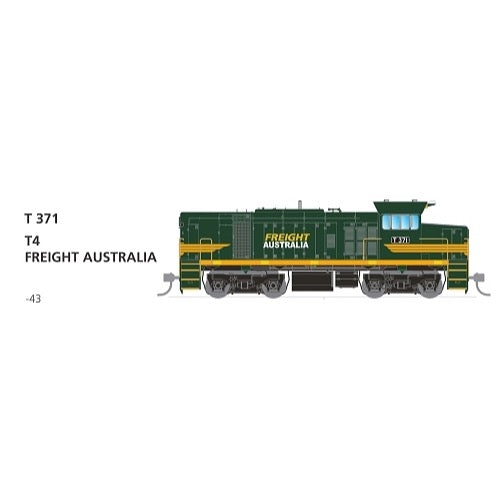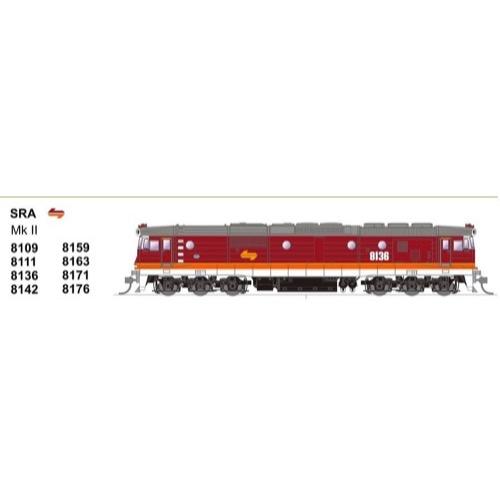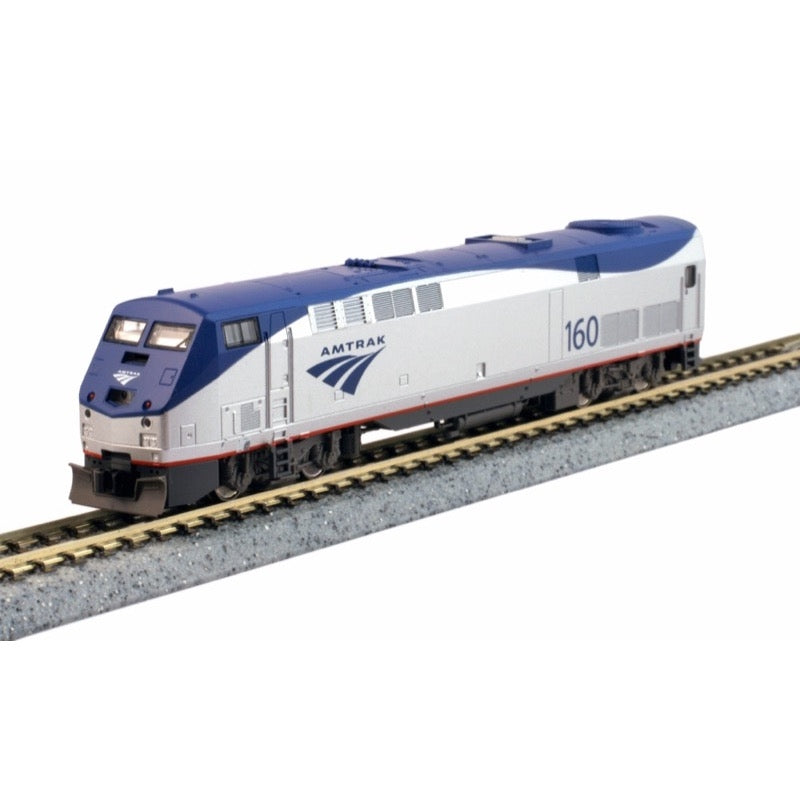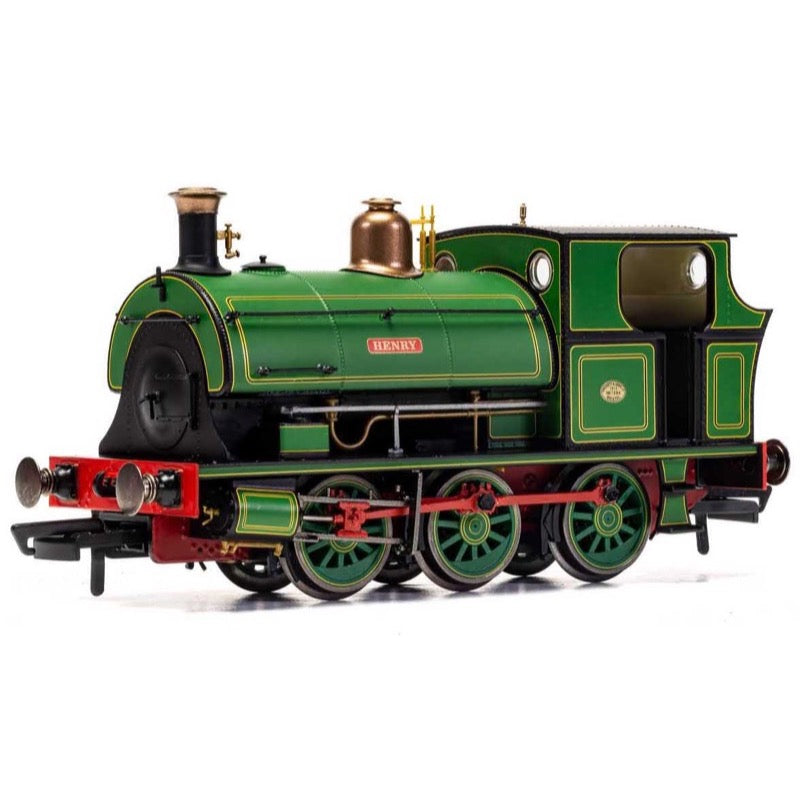
Hornby R3871 OO Port of Bristol Authority Peckett B2 Class 0-6-0 ST1264/1913 Henry
108.00
$
<p>The Peckett B Class was a classic six-coupled, industrial saddle tank type locomotive of the late Victorian/Edwardian era that covered three different variants, from the B1 through to the B3. The original version of the B1 was a Fox Walker design and featured a smokebox that extended beyond the saddle tank, an open cab and a flared top coal bunker. When the firm Peckett & Sons Ltd took over the business established at the Atlas Engine Works in St. George, Bristol, by Fox, Walker & Company in 1880, the initial B1 locomotives produced by the firm, followed the Fox Walker design.</p>
<p>By 1890, the Peckett B1 design, with its extended covered cab and full-length saddle tank, had evolved and in 1905 a new upgraded version appeared, the B2 Class.The Peckett B2 0-6-0ST had the appearance of being a more compact locomotive than its predessor, although in reality it was the bigger cab and external coal bunker that tended to give this impression.</p>
<p>The first of the class, No. 1051, was sold new in 1905 to the Trimsaran Colliery in Wales and while no more than four locomotives were ever produced in a year, production continued until 1931 when No. 1802 was sold to Hardwick Colliery Co. Ltd.Peckett B2 No. 1264 was built in 1264 and served at the Avonmouth Docks. The locomotive was named 'Henry' and was one of many Pecketts serving at the docks. In later years, the railway system was worked by Sentinel diesel locomotives before closing in 1983.</p>
<h3>Specifications</h3>
<ul>
<li>Item Length - Without Packaging (cm): 9.7</li>
<li>Item Height - Without Packaging (cm): 5</li>
<li>Item Width - Without Packaging (cm): 3.5</li>
<li>Item Weight - Without Packaging: 0.18</li>
<li>Item Scale: 1:76 Scale 00 Gauge</li>
<li>License: No</li>
<li>Finish: Painted</li>
<li>Colour: Green</li>
<li>Gauge: OO</li>
<li>DCC Status: DCC Ready 4 pin socket</li>
<li>Operator: Port of Bristol Authority</li>
<li>Designer: Peckett & Sons</li>
<li>Livery: Port of Bristol Authority Green</li>
<li>Minimum Curve (mm): Radius 1</li>
<li>Motor: 3 Pole</li>
<li>Number of Parts: 1</li>
</ul>
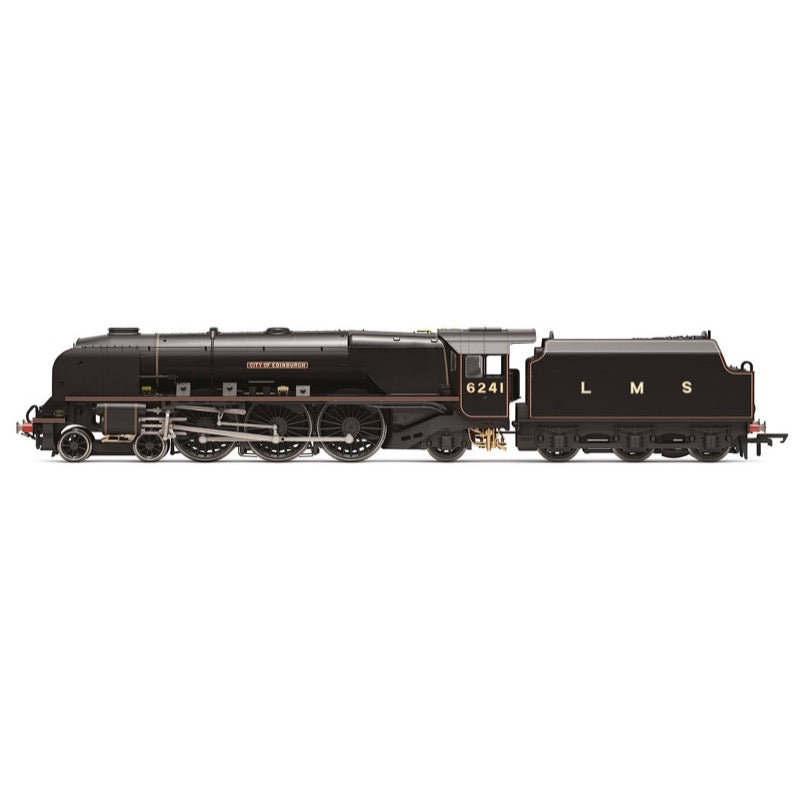
Hornby R3681 OO LMS Princess Coronation Class 4-6-2 6241 City of Edinburgh
150.00
$
<p>The story of the Princess Coronation Class is one of split personalities and purposes and represents the difference in opinions and attitudes between design on the one hand, and perceived cost savings on the other. </p>
<p>The original streamlined form of the class arose from tests by the London Midland Scottish Railway's Research Department on Stanier's development of the Princess Royal class locomotives. Stanier was said to be ambivalent about the economic value of streamlining but was aware of the publicity value of such a design. When the opportunity to produce five conventional versions of the Coronation Pacific as a comparison to the streamlined version arose, Stanier was quoted as saying, 'They can have their streamliners if they b***** want them, but we will also build them five proper ones'.</p>
<p>Those first five conventional locomotives were 6230 Duchess of Buccleuch to 6234 Duchess of Abercorn and colloquially they were known as Duchesses, after the first of this sub-class. Appearing in 1938 with a single chimney and without smoke deflectors, it is this form that many purists regard as the finest Pacific locomotive produced. The next four Duchesses to appear were 6249-6252 in 1944 and they emerged from works with a double chimney.</p>
<p>Originally ordered as streamlined, the demands of maintaining the streamlined form exceeded the cost savings in coal and so they emerged from works without the casing, but with streamlined tenders (which had been completed before that decision was taken). In 1946 the next three Duchesses, 6253-6255, differed in appearance again, this time the curved fall plate at the front was replaced by a split platform and smoke deflectors were fitted. The final 'as new' produced Duchesses were 6256 and 46257 (as it appeared straight into British Railways ownership) and these were modified designs by Ivatt, featuring a different cab, pony truck, reversing gear and roller bearings.</p>
<p>The process of de-streamlining (or defrocking as the fitters called it) the remaining engines began with 6235 City of Birmingham in April 1946, with 6243 City of Lancaster being the last in May 1949. Because the smokeboxes were angled down between the chimney and door to accommodate the sweep of the streamlined casing, upon defrocking they retained this look, being referred to as semi-streamlined by enthusiasts of the time. Eventually the raked smokeboxes were replaced with conventional smokeboxes, so that by late 1958 the majority of the fleet showed a similar appearance, although all the defrocked locomotives had the split platform "utility" front end.</p>
<p>Withdrawal of the class commenced in December 1962 and by October 1964 all had been withdrawn. Fortunately, three locomotives were saved for preservation; 6229 Duchess of Hamilton, 6233 Duchess of Sutherland and 6235 City of Birmingham. 6241 Duchess of Edinburgh was built streamlined at Crewe and entered traffic at Camden on April 13, 1940, paired with tender 9804. The streamlined casing was removed on February 2, 1947 whilst the locomotive was still at Camden, a shed where 6241 spent the majority of its working life. In storage between November 1962 and February 1963, then again between October 1963 and March 1964, 6241 Duchess of Edinburgh was withdrawn in September 1964.</p>
<h3>Specification</h3>
<ul>
<li>Item Scale: 1:76 Scale 00 Gauge</li>
<li>DCC status: DCC Ready 8 pin socket</li>
<li>Finish: Painted</li>
<li>Gauge: OO</li>
<li>Operator: LMS</li>
<li>Designer: Sir William Stanier</li>
<li>Wheel arrangement4-6-2</li>
<li>Minimum radius curve: 2nd Radius (438mm)</li>
<li>Motor: 5 pole skew wound</li>
<li>Coupling: NEM</li>
</ul>
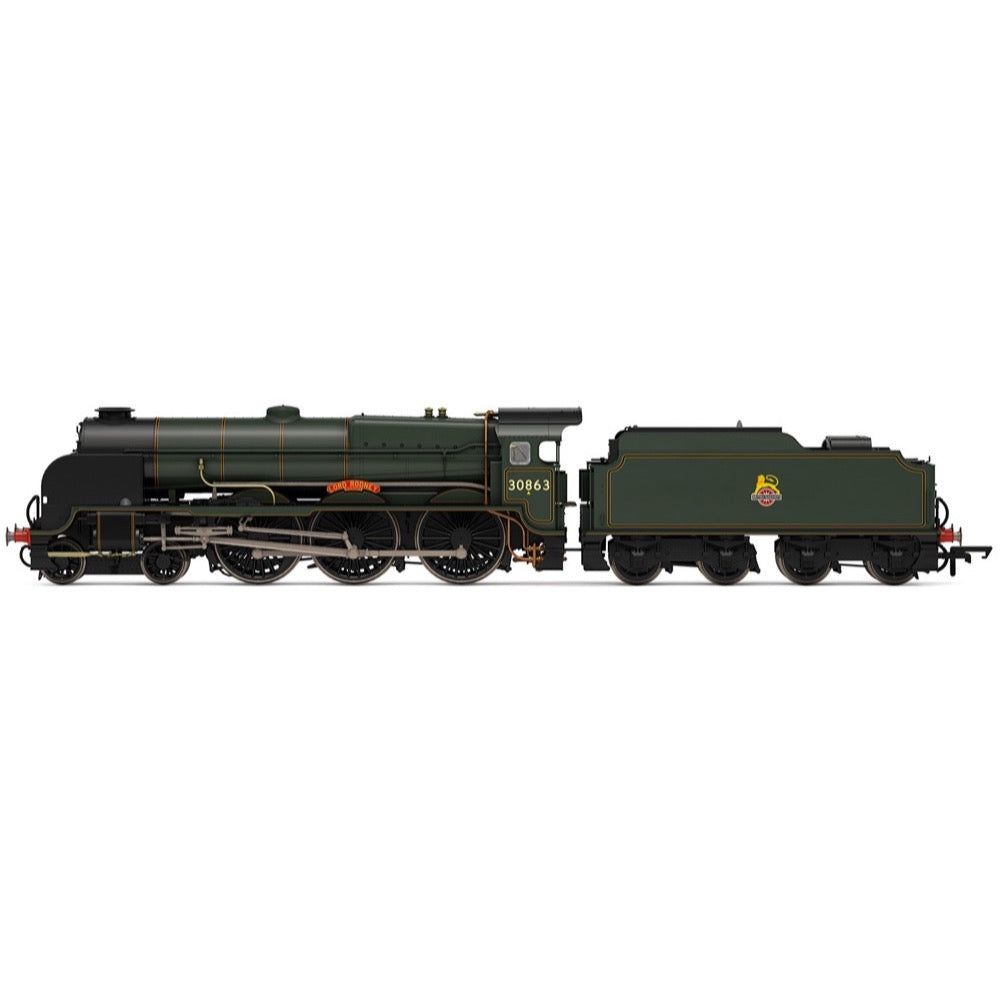
Hornby R3635 OO BR Lord Nelson Class 4-6-0 30863 Lord Rodney Era 4
158.00
$
<p>In order to cope with the steadily increasing weight of express passenger traffic on the Southern Railway in the early years of Grouping, Richard Maunsell, the Chief Mechanical Officer, needed a locomotive that was more powerful than the King Arthur class, but one that would still conform to the various gauging and weight issues within the region and still be capable of hauling 500 ton trains at a speed of 55mph.</p>
<p>The new Lord Nelson design had to fit within the profile of the King Arthur class and having previously used a Drummond four cylinder locomotive as a test bed, Maunsell altered the positions of the cranks on the Lord Nelson design to give eight exhaust pulses per revolution, rather than four. The resulting increase in power over the two cylinder design of the King Arthur class was significant. A longer, Belpaire boiler, with a completely differently designed firebox was used, the cab design was similar to the L1 4-4-0 and the bogie was of a new design, being independently coil-sprung.</p>
<p>Maunsell decided to produce one example as a prototype ordered from Eastleigh Works on May 29, 1925, which replaced the last engine on an existing King Arthur build order. The locomotive, No. E850, was completed on August 11, 1926 and after trials at Eastleigh, was sent to Nine Elms for trial running on the Western section mainlines to Bournemouth, Portsmouth and Exeter before moving across to Battersea for trials on the Dover boat trains.</p>
<p>Although areas for improvement were noted, there was enough confidence in the locomotive's design for a further fifteen engines to be ordered; ten on March 13, 1927 and a further five on March 23, 1928. These locomotives were completed at Eastleigh between June 1928 and November 1929 and once the decision was taken to name the class after naval leaders, the Southern Railway's publicity department went to work promoting the introduction, basing their claim of the class being 'the most powerful express locomotive in Britain' on the theoretical tractive power of 33,300lbf.</p>
<p>Both Maunsell and his successor, Oliver Bulleid, bought a number of modifications to the class, the most noticeable being the introduction of smoke deflectors but chimneys, bogie frames and cylinders were all modified, giving a subtle range of external differences over the pre-war appearance of the class.</p>
<p>Post-war, speed recorders and AWS apparatus were added by British Railways but it was the range of tenders that added interest. For most of their service life, the class ran with flat-sided 5000 gallon bogie tenders, but modified Urie style 5000 gallon bogie tenders from the S15 class were also used, along with 4000 gallon six-wheel tenders. The first withdrawal came in May 1961, the last in October 1962 and one locomotive, No.30850 Lord Nelson, was saved for preservation in the National Collection.</p>
<p>Built at Eastleigh in October 1929, 863 Lord Rodney entered traffic at Stewarts Lane, before moving to Nine Elms in October 1938 following the fitting of an experimental large diameter chimney. Moving between these two sheds, Lord Rodney moved to Bournemouth in June 1945, but was at Nine Elms when renumbered under British Railways to 30863 in August 1949. Whilst at Eastleigh in 1956, Lord Rodney had the front end renewed following a collision, but was not withdrawn from traffic until February 1962.</p>
<h3>Specification</h3>
<ul>
<li>Item Length - Without Packaging (cm): 36.2</li>
<li>Item Height - Without Packaging (cm): 5.8</li>
<li>Item Width - Without Packaging (cm: 0.2</li>
<li>Item Weight - Without Packaging: 0.55</li>
<li>Item Scale: 1:76 Scale 00 Gauge</li>
<li>License: No</li>
<li>Finish: Painted</li>
<li>Colour: Green</li>
<li>Gauge: OO</li>
<li>DCC Status: DCC Ready 8 pin socket</li>
<li>Operator: British Railways</li>
<li>Designer: Richard Maunsell</li>
<li>Wheel Configuration: 4-6-0</li>
<li>Livery: Early Crest</li>
<li>Minimum Curve (mm): Radius 2</li>
<li>Number of Parts: 1</li>
<li>Class: Lord Nelson Class</li>
</ul>
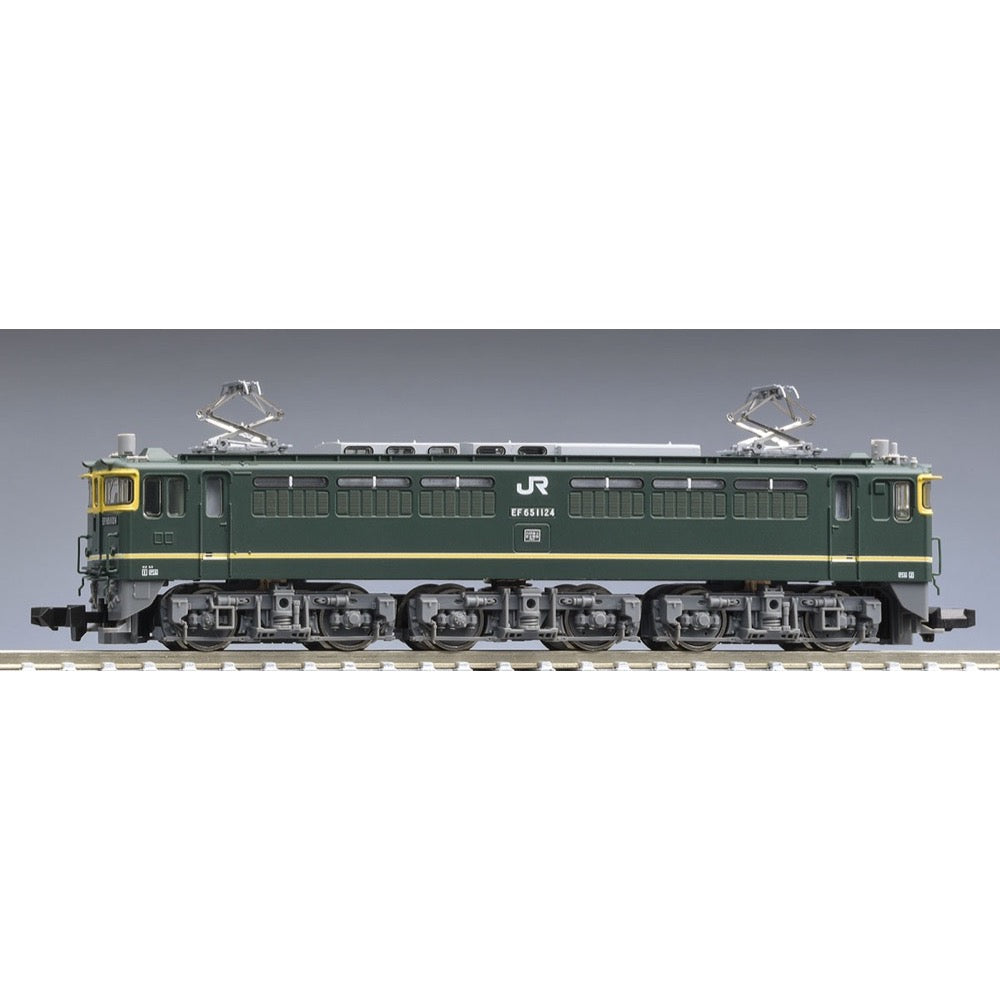
Tomix 7175 N 7175 EF65-1000 Electric Locomotive No.1124 Twilight Color Grey Bogie
54.00
$
<p>EF65 No. 1124 was repainted in twilight color in 2015 to tow the "Special Twilight Express", and in 2019 the undercarriage color was changed to gray and an air conditioner was installed. It is now mainly used to tow rail and ballast transport trains.</p>
<h3>Features</h3>
<ul>
<li>Newly produced side with air conditioning duct</li>
<li>Reproduces the appearance of the taillight lens in milky white</li>
<li>Roof-mounted monitor reproduced in gray</li>
<li>See-through driver's cab expression</li>
<li>H-rubber reproduced in black</li>
<li>Front handrail (vertical) comes as a separate part</li>
<li>Release lever already attached as a separate part</li>
<li>Number plate comes as a separate part "EF65-1124"</li>
<li>Headlights equipped with constant lighting board</li>
<li>Headlights are lit by incandescent color LED</li>
<li>Signal flare and whistle come as separate parts</li>
<li>Uses power with flywheel</li>
<li>Uses gray bogie frame and silver wheels</li>
<li>Uses wheels with plate wheel center</li>
<li>Includes dummy coupler and self-coupling TN coupler</li>
<li>Uses M-13 motor</li>
<li>Can run on mini curved rails</li>
</ul>
<h3>Accessories</h3>
<ul>
<li>Runner parts: Front handrail (vertical)</li>
<li>Runner parts: Number plate (front and side)</li>
<li>Runner parts: Manufacturer's plate</li>
<li>Runner parts: Whistle, signal flare, radio antenna</li>
<li>Parts: Automatic TN coupler</li>
<li>Parts: Automatic dummy coupler</li>
<li>Parts: Dummy coupler base</li>
<li>Parts: Jig</li>
</ul>
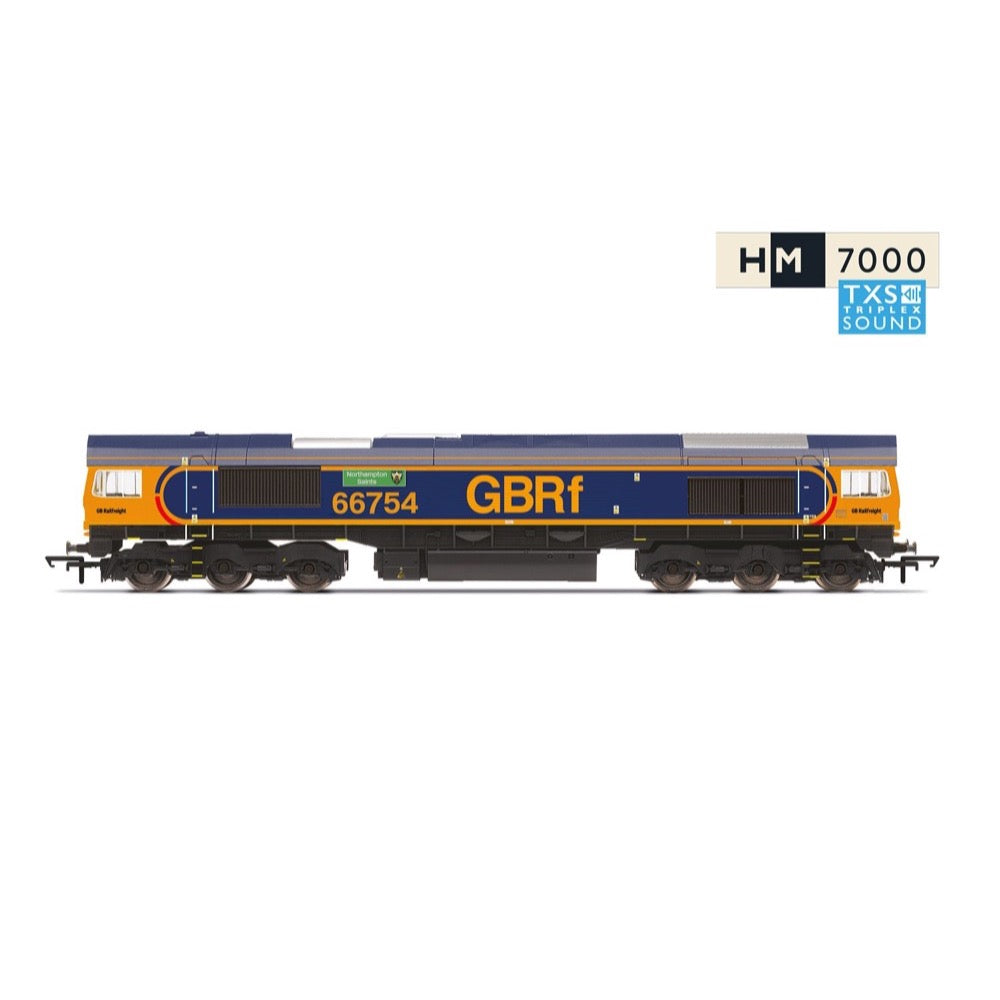
Hornby R30353TXS GBRf Class 66 Co-Co 66754 Northampton Saints 2014 - 2024 Sound Fitted Locomotive
75.00
$
<p>GB Railfreight ordered 21 Class 66 locomotives, including No. 66754 ‘Northampton Saints’, from Electro-Motive Diesel (EMD) between September 2013 and February 2014. These Class 66 locomotives hauled biomass for electricity generation and infrastructure materials for Network Rail. On 22nd April 2015, 66754 was named ‘Northampton Saints’ after the rugby club in a special naming ceremony. At the time, it was to celebrate their most successful season in over 60 years, which included 9 cup finals in 7 years, the 2014 Aviva Premiership and European Challenge Cup titles. The naming ceremony took place at the Wellingborough Railhead in Northampton, near Franklin’s Gardens which is Northampton Saints’ ground.</p>
<p>Our No. 66754 model is painted in the classic GBRf blue livery. It includes two etched nameplates of ‘Northampton Saints’. Please be aware that this is not suitable for children. This model is DCC-ready and is compatible with our HM7000 21-Pin decoder, including sound. The Class 66 HM7000 sound profile corresponds to this model. The accessory bag contains a pair of snow ploughs, four vac pipes and two moulded coupling links.</p>
<h4>Includes</h4>
<ul>
<li>1x Locomotive Diesel</li>
</ul>
<h4>Technical Specifications</h4>
<div>
<ul>
<li>Item Length - Without Packaging (cm): 28</li>
<li>Item Height - Without Packaging (cm): 5</li>
<li>Item Width - Without Packaging (cm): 3.5</li>
<li>Item Weight - Without Packaging: 0.705</li>
<li>Finish: Painted</li>
<li>Colour: Blue</li>
<li>Gauge: OO</li>
<li>DCC Status: HM7000-21TXS: Bluetooth® & DCC Sound Decoder (21-pin)</li>
<li>Operator: GBRf</li>
<li>Designer: Electro-Motive Diesel</li>
<li>Livery: GBRf Blue</li>
<li>Wheel Configuration: Co-Co</li>
<li>Minimum Curve (mm): Radius 2</li>
<li>Motor: 3 Pole</li>
<li>Number of Parts: 1</li>
<li>Class: Class 66</li>
<li>Buffer Type: Separate Plastic Buffers</li>
<li>Coupling Type: NEM Couplings</li>
<li>Hornby Decoder Compatibility Primary: HM7000-21TXS: Bluetooth® & DCC Sound Decoder (21-pin)</li>
</ul>
</div>

Hornby R30351 BR Class 9F 2-10-0 92203 Black Prince 2014 - 2024 Locomotive
166.00
$
<p>The BR Standard Class 9F steam locomotives were designed by Robert Riddles and they were intended to haul heavy freight trains over long distances. No. 92203 was constructed at Swindon Works and delivered on 6th April 1959. 92203 soon hauled heavy iron ore trains from Bidston Dock to Shotwick Shotton steelworks. After being in service for less than nine years, the locomotive was withdrawn in November 1967. The artist David Shepherd purchased 92203 from BR for £3,000 and it was then used on the Longmoor Military Railway. Shepherd named the locomotive ‘Black Prince’. After visiting several heritage railways, the locomotive moved to the North Norfolk Railway, its current home.</p>
<p>This classic 9F model and tender is painted in an austere BR black livery. It includes two etched nameplates of ‘Black Prince’. Please be aware that this is not suitable for children. This model is DCC-ready and is compatible with our HM7000 21-pin decoder. The accessory bag contains a tender brake rod, an NEM coupling assembly, a hook coupling, a bar coupling, a front foot step for both left and right, a front vac pipe, an AWS guard and two crew figures: a driver and fireman.</p>
<h3>Specification</h3>
<ul>
<li>Item Length - Without Packaging (cm): 27</li>
<li>Item Height - Without Packaging (cm): 5</li>
<li>Item Width - Without Packaging (cm): 3.5</li>
<li>Item Weight - Without Packaging: 0.45</li>
<li>Item Scale: 1:76 Scale 00 Gauge</li>
<li>Finish: Painted</li>
<li>Colour: Black</li>
<li>Gauge: OO</li>
<li>DCC Status: DCC Ready 21 pin socket</li>
<li>Operator: BR</li>
<li>Designer: Robert Riddles</li>
<li>Wheel Configuration: 2-10-0</li>
<li>Livery: BR Black</li>
<li>Minimum Curve (mm): Radius 2</li>
<li>Motor: 5 Pole Skew wound</li>
<li>Number of Parts: 1</li>
<li>Class: Class 9F</li>
<li>Buffer Type: Metal Sprung Buffers</li>
<li>Coupling Type: NEM Couplings</li>
<li>Hornby Decoder Compatibility Primary: HM7000-21TXS: Bluetooth® & DCC Sound Decoder (21-pin)</li>
</ul>
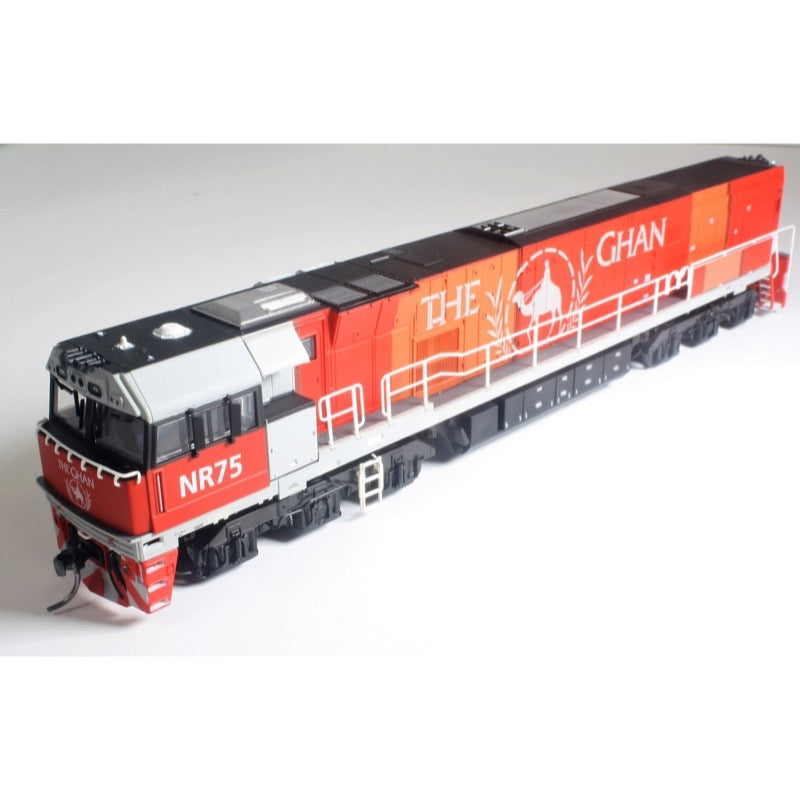
SDS Models NR514 HO NR75 The Ghan Mk2 NR Class Locomotive DCC Sound
177.00
$
<p>Introduced in 1996 by National Rail Corporation these 120 units were built by A Goninan and Co. The locomotives are 3000kw General Electric powered and used on standard gauge Australia wide.</p>
<p>They were introduced in grey and marigold and several were painted into various business units of NRC. Later they wore GSR train liveries representing the Hook and Pull agreement between the two companies.</p>
<p>In 2002 Pacific National acquired the assets of NRC and commenced to repaint the NR class into their new blue and yellow colours.</p>
<p>The model features the current tooling from Austrains and includes operating headlights, marker and ditch lights and is Kadee equipped. These are an ideal way to add colour to your collection.</p>
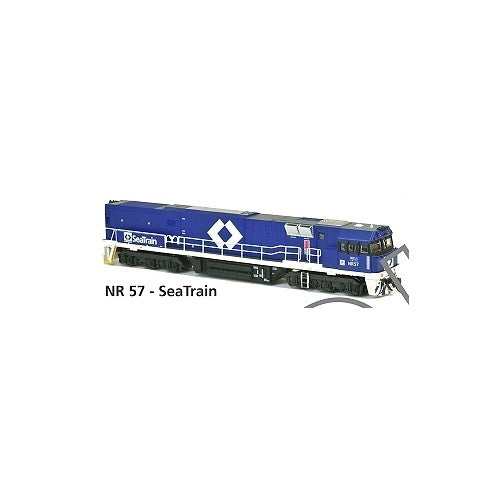
SDS Models HO NR57 Seatrain National Rail NR Class Locomotive
123.00
$
<p>Introduced in 1996 by National Rail Corporation these 120 units were built by A Goninan and Co. The locomotives are 3000kw General Electric powered and used on standard gauge Australia wide.</p>
<p>They were introduced in grey and marigold and several were painted into various business units of NRC. Later they wore GSR train liveries representing the Hook and Pull agreement between the two companies.</p>
<p>In 2002 Pacific National acquired the assets of NRC and commenced to repaint the NR class into their new blue and yellow colours.</p>
<p>The model features the current tooling from Austrains and includes operating headlights, marker and ditch lights and is Kadee equipped. These are an ideal way to add colour to your collection.</p>
<h3>Features</h3>
<ul>
<li>Highly detailed Ready-to-Run HO gauge model</li>
<li>Precisely tooled plastic body (ABS)</li>
<li>Genuine Kadee scale head whisker coupler</li>
<li>Separately applied handrails and detail parts</li>
<li>5-Pole skew wound electric motor and dual flywheels</li>
<li>All wheel drive and electrical pickup</li>
<li>LED headlights, marker lights, number boxes and ditch lights</li>
<li>All models come standard with an MTC 21 pin motherboard</li>
</ul>
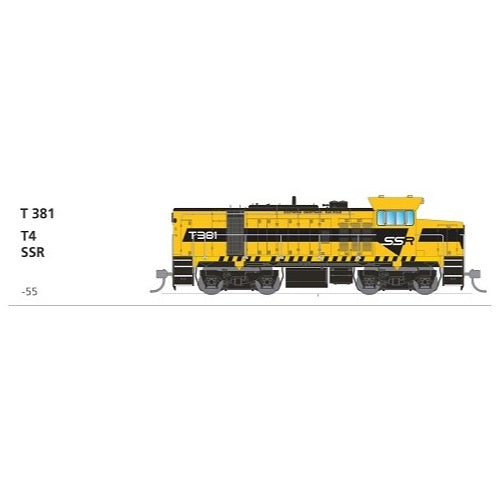
SDS Models HO T381 SSR T4 Series T Class Locomotive
123.00
$
<p>SDS Models HO T381 SSR T4 Series T Class Locomotive</p>


